FEATURE ARTICLE: FIRST HOME BUYERS IN AUSTRALIA
INTRODUCTION
Home ownership is a widely held aspiration in Australia, providing security of tenure and long-term economic benefits to home owners. Housing is also very significant in the national economy in terms of investment levels, building activity and employment.
Australia has one of the highest levels of home ownership in the world. Results from the Census of Population and Housing show that home ownership was at 70% in 2006, little changed over the past 40 years (see table 1). Small fluctuations in measured home ownership rates derived from census data in part reflect methodological differences from Census to Census.
1. ALL OCCUPIED PRIVATE DWELLINGS, By tenure type |
|
 | Owner without
a mortgage | Owner with
a mortgage | All owner
occupied
private
dwellings | Renter | Other
Tenure | Total
(a) | Proportion of
owner occupied
private dwellings |
| Year | `000 | `000 | `000 | `000 | `000 | `000 | % |
|
| 1966(b) | na | na | 2 232 | 835 | 60 | 3 127 | 71.4 |
| 1971(b) | na | na | 2 469 | 1 001 | 119 | 3 589 | (c)68.8 |
| 1976 | 1 306 | 1 438 | (d)2 762 | 1 045 | 232 | 4 039 | (e)68.4 |
| 1981 | 1 549 | 1 543 | (d)3 179 | 1 164 | 191 | 4 534 | 70.1 |
| 1986 | 1 982 | 1 604 | 3 586 | 1 334 | 174 | 5 095 | 70.4 |
| 1991 | 2 362 | 1 561 | 3 923 | 1 561 | 210 | 5 694 | 68.9 |
| 1996 | 2 658 | (f)1 656 | 4 314 | 1 866 | 68 | 6 248 | 69.0 |
| 2001 | 2 811 | (f)1 872 | 4 683 | 1 953 | 101 | 6 737 | 69.5 |
| 2006 | 2 478 | (f)2 448 | 4 926 | 2 064 | 66 | 7 056 | 69.8 |
|
| na not available |
| (a) Excludes not stated. |
| (b) Separate figures for owners without a mortgage and owners with a mortgage are not available for these years. |
| (c) Following the 1967 Referendum and a subsequent change in the Indigenous question wording in the Census in 1971, the Indigenous census count increased 45%. This change made a small contribution to the decrease in the measured proportion of owner occupied private dwellings. |
| (d) Includes 'owner/purchaser undefined' which account for 0.4% of the total in 1976 and 1.9% in 1981. In subsequent years only the specific categories of 'owner with a mortgage' and 'owner without a mortgage' were included on Census forms, which may have resulted in some decline in measured ownership rates. |
| (e) Due to budgetary restraints, the ABS was unable to complete the normal processing of the data and a 50% sample was processed. The impact of this on the measured proportion of owner occupied private dwellings is not clear. |
| (f) Includes dwellings 'Being purchased under a rent/buy scheme'. These accounted for 0.5% of occupied private dwellings in 1996, 0.7% in 2001 and 0.2% in 2006. In previous years this tenure category was not separately catered for on Census forms and it is not known how households with rent/buy tenure would have responded to the questions on tenure. |
| ABS data available on request, Census of Population and Housing. |
While at any one time most people in Australia are living in owner occupied dwellings, many factors influence when and if people enter the housing market for the first time (ie become first home buyers). For many, the decision to become a first home buyer (FHB) will reflect their life cycle stage (partnering, having children) and their capacity to finance the purchase of a dwelling and service that financial commitment. For some people, acquisition of other assets may take precedence over housing.
This article examines the characteristics of FHBs and how they have changed since the early 1990s.
HOUSING FINANCE
From June 1991 to June 2007, the number of FHB finance commitments (see graph 2) has averaged about 27,000 commitments per quarter, but has fluctuated between 16,000 and 41,000 commitments per quarter. Some of the fluctuations in the series may reflect potential FHB responses to changes in interest rates (see graph 3). The introduction in July 2000 of the First Home Owner Grant (FHOG), and an additional FHOG that was made available up until June 2002, are likely to have brought forward some FHB decisions into that 2 year time period.
2. FHB finance commitments
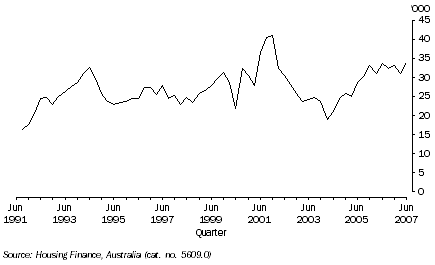 3. Home loan interest rates,
3. Home loan interest rates, Standard variable rate (a)
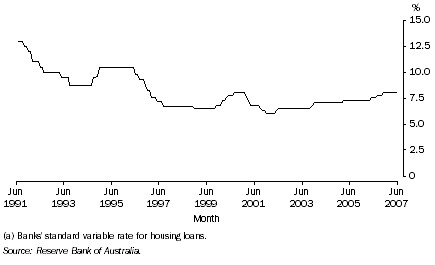
FHB WITHOUT A MORTGAGE
In the ABS Survey of Income and Housing (SIH) a FHB is defined as a household in which the reference person for that household (or their co-resident partner) bought the dwelling in which they reside in the three years prior to being interviewed, and neither that reference person nor their co-resident partner had owned a home previously.
In the 2005-06 SIH, 318,000 Australian households had purchased their first home in the 3 years prior to interview. Of these, 95% owned their home with a mortgage at the time of interview, up from 82% in 1995-96 (see table 4).
The 5% of FHB households without a mortgage in 2005-06 had an average household net worth of $882,000, compared to $236,000 for FHB households with a mortgage. One in two of those FHB households without a mortgage were lone person households.
4. FHB households with and without a mortgage |
|  |
 | FHBs without a mortgage | FHBs with a mortgage | All FHB households | Proportion of FHBs with a mortgage |  |
 | '000 | '000 | '000 | % |  |
|  |
| 1995-96 | 68.6 | 318.2 | 386.8 | 82.3 |  |
| 1996-97 | 45.6 | 329.9 | 375.5 | 87.9 |  |
| 1997-98 | 58.8 | 387.1 | 445.9 | 86.8 |  |
| 1999-00 | 65.9 | 328.2 | 394.1 | 83.3 |  |
| 2000-01 | 55.0 | 358.2 | 413.1 | 86.7 |  |
| 2002-03 | 38.6 | 384.2 | 422.8 | 90.9 |  |
| 2003-04 | 21.2 | 372.8 | 394.0 | 94.6 |  |
| 2005-06 | *14.6 | 303.3 | 317.7 | 95.4 |  |
|  |
| * estimate has a relative standard error of 25% to 50% and should be used with caution |
| ABS data available on request, Survey of Income and Housing |
| Survey not run in 1998-99, 2001-02 or 2004-05. |
FHB WITH A MORTGAGE
The remainder of this article focuses on FHBs with a mortgage. Most of the data referred to is included in tables 12 to 14 at the end of this article.
Most FHBs with a mortgage in 2005-06 were relatively young, with 68% having the reference person aged under 35 years. Only 10% of FHBs with a mortgage had the reference person aged 45 years or older. Between 1995-96 and 2005-06 the average age of the reference person remained between 31 and 33 years. The age distribution of the reference person in these households did not change significantly over this period.
Partnering often precedes home purchase, and often has the advantage of providing two incomes to meet the associated housing costs, particularly during the initial loan repayment period. Couple households made up the majority (68%) of FHBs with a mortgage in 2005-06, with just over half of these including children. A further 20% were lone person households. There has been little change in the family composition of FHBs with a mortgage since 1995-96.
In 2005-06, the majority (57%) of FHBs with a mortgage had at least two income earners, a proportion that has remained broadly unchanged since 1995-96. All but 2% of these households had someone in full or part-time employment at the time of the survey.
Over two thirds (70%) of reference people in FHB households with a mortgage had a non-school qualification in 2005-06, up from 58% in 1995-96. In 2005-06, 33% had a bachelor degree or higher, compared with 18% a decade earlier.
In 2005-06, educational attainment was a little lower in the general population in the age group 18-44 years (a reasonable approximation to the FHB age group). In this population 62% had a non-school qualification, compared to 70% for FHBs with a mortgage.
HOME PURCHASES
On average, FHBs with a mortgage purchase less expensive homes than changeover buyers i.e. households that bought their home in the preceding three years, but had previously owned another dwelling. In 2005-06 the mean value of the dwelling for FHBs with a mortgage (as estimated by the householder) was $310,000, compared to $428,000 for changeover buyers and $412,000 for all owner households (see graph 5).
Between 1995-96 and 2005-06 the mean value of dwellings, estimated by their owners at the time of interview, was consistently substantially lower for FHBs with a mortgage than for changeover buyers. After adjustment for inflation, the mean value of dwellings for FHBs with a mortgage increased by 87% over this period (from $165,000 to $310,000), compared with 65% for changeover buyers.
5. Mean estimated value of dwelling (a), By owner type
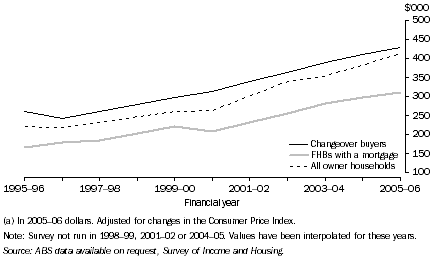
Dwelling type
Although separate houses have continued to be the most favoured form of housing in Australia, there has been a shift among FHBs with a mortgage towards medium and high density housing (which includes semi-detached houses, terrace houses, townhouses, flats, units and apartments). In 2005-06, 27% of FHBs with a mortgage occupied these types of dwellings, up from 15% in 1995-96.
In 2005-06, FHBs with a mortgage lived in smaller dwellings, on average (2.94 bedrooms), than either changeover buyers (3.30 bedrooms) or all owner households (3.26 bedrooms). This, along with the differences in house prices, indicates that FHBs with a mortgage occupy different segments of the housing market to changeover buyers.
Despite the FHB trend towards medium and higher density housing, the average number of bedrooms for dwellings occupied by FHBs with a mortgage has been largely unchanged since 1995-96. This is partly due to the larger size of semi-detached houses, terrace houses and townhouses now occupied by FHBs with a mortgage, up from 2.2 bedrooms in 1995-96 to 2.6 bedrooms in 2005-06.
The proportion of FHBs with a mortgage buying new homes, as opposed to established homes, fell from 23% in 1995-96 to 14% in 2005-06.
Housing loans
FHBs borrow less money, on average, than non-first home buyers. In 2006-07 the average amount borrowed by FHBs with a mortgage was $223,000 (in 2005-06 dollars), while the average amount borrowed by non-first home buyers with a mortgage was $231,000 (see graph 6).
In real terms, the average size of loans taken out by FHBs with a mortgage rose by $124,000 (or 124%) since 1991-92, mainly reflecting the rise in dwelling values over this period.
6. Average loan size (a), Purchase of owner occupied dwellings with a mortgage
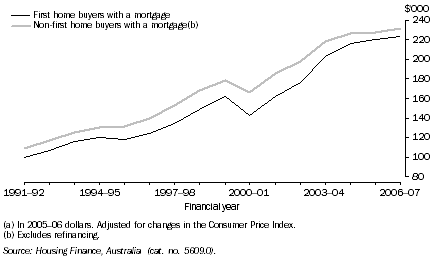
HOUSEHOLD ECONOMIC RESOURCES
The capacity of a household to purchase a home and to service the ongoing costs of a home loan, together with other household costs, is largely determined by its access to economic resources, notably the incomes and wealth of its members.
Income
FHBs with a mortgage tend to have higher than average household incomes. In 2005-06, they had an average weekly gross income of $1,544, 18% higher than the average for all households. Just over 60% of people in FHB households with a mortgage were in the top two quintiles (40%) of equivalised disposable household income in 2005-06 (see graph 7). Only 18% were in the bottom two quintiles (40%). This is consistent with their higher than average number of persons employed per household (1.60 compared with 1.26 for all households).
7. Income distribution, FHBs with a mortgage, 2005-06
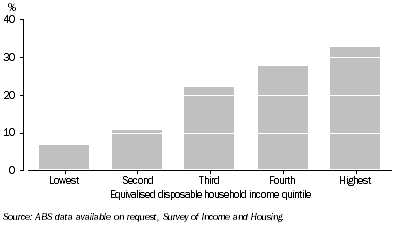
Between 1995-96 and 2005-06 the average real disposable income of people living in FHB households with a mortgage increased by 31%, a little lower than the average increase for people living in all households (up 35% over the same period) and on a par with the 31% for those living in what are described as 'low income households' (ie those in the second and third equivalised disposable income deciles).
Over the same period, the distribution of equivalised disposable household income of FHBs with a mortgage remained broadly unchanged. The proportion of people from FHB households with a mortgage who were in the bottom three equivalised disposable income quintiles rose slightly from 39% in 1995-96 to 40% in 2005-06.
Wealth
Although FHBs with a mortgage have higher than average incomes, they have lower than average net worth. In 2005-06 FHBs with a mortgage had mean net worth of $236,000, 42% below the average net worth for all households. This is consistent with the young age profile of FHBs with a mortgage, and the common pattern of people gradually accumulating wealth throughout their working life, including through the acquisition of a dwelling and the increasing equity in it, as it appreciates in value over time and as mortgages are repaid.
Home equity
For many FHBs with a mortgage, the equity accumulated in their home represents the major part of their household wealth. Equity is measured as the value of the dwelling less the reported value of any outstanding loans secured against the dwelling. In 2005-06 FHBs with a mortgage had a mean dwelling equity of $97,000. Since 1995-96, the real mean dwelling equity of FHBs with a mortgage has increased by 62% (see graph 8).
The average amount of principal owed (mortgage outstanding) on the homes of FHBs with a mortgage was $213,000 in 2005-06, an increase of 102% in real terms since 1995-96. The faster rate of increase in the principal outstanding on FHB homes owned with a mortgage reflects the increases in house prices and therefore the mortgages taken out to acquire them, although some of the increased loan amounts may reflect borrowing for other, subsidiary purposes, as well as dwelling acquisition.
8. Mean mortgage outstanding and mean equity in dwelling (a) (b), FHBs with a mortgage
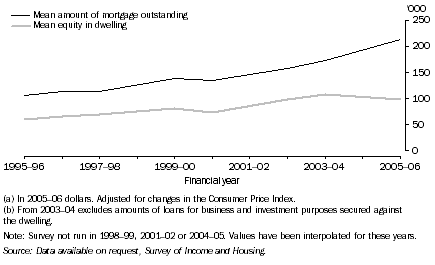
Housing costs
In this article housing costs for owners with a mortgage refer to rate payments and mortgage or unsecured loan payments, if the initial purpose of the loan was primarily to buy, add or alter the dwelling. Additional housing costs incurred by owners such as repairs, maintenance and dwelling insurance are not collected in the SIH.
In 2005-06 average weekly housing costs of FHBs with a mortgage were $415, or 27% of gross household income. Between 1995-96 and 2005-06, this amount rose $116 per week (or 39%) in real terms (see graph 9), a little higher than the increase in their real gross household incomes over the same period (up 33%).
9. Average weekly housing costs (a), FHBs with a mortgage
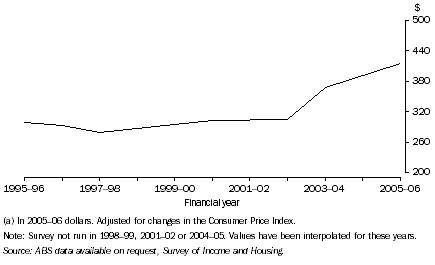
The interest component of mortgage repayments for FHBs with a mortgage was the largest part of their weekly housing costs. In 2005-06, interest on the loan accounted for 70% of the housing costs of FHBs with a mortgage, compared to 67% for changeover buyers with a mortgage and 64% for all owner households with a mortgage. The equivalent proportions in 2003-04 were 64%, 66% and 59% respectively.
Disposable income less housing costs
The income available to FHBs with a mortgage to support other household consumption, after deducting housing costs from their disposable income, provides a further indication of their economic circumstances.
In 2005-06 the average disposable household income, less housing costs, was $800 per week for FHBs with a mortgage. In real terms, this has risen 27% from $629 per week in 1995-96 (see graph 10).
10. Mean weekly disposable income, housing costs and disposable income less housing costs (a), FHBs with a mortgage
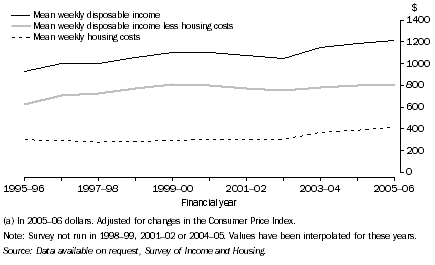
The principal component of mortgage repayments can be considered to be a form of saving rather than a recurrent housing cost. In 2005-06 the average principal component was $123 per week for FHBs with a mortgage. Excluding this from the measure of housing costs would result in an average disposable income net of housing costs of $923 per week in 2005-06.
Lower income households
Households with low or moderate incomes and limited reserves of wealth may have difficulty obtaining finance or meeting the ongoing costs of owning a home with a mortgage, particularly in periods when house prices are rising quickly.
In this publication 'lower income households' have been defined as those containing the 30% of people with equivalised disposable household income between the 10th and 40th percentiles. While the majority of FHBs with a mortgage have higher than average incomes, 14% of FHBs with a mortgage were from lower income households. This proportion has remained broadly unchanged since 1995-96.
In 2005-06 the average age of the reference person in lower income FHB households with a mortgage was 35 years, compared to 32 years for other FHB households with a mortgage (see table 13 at the end of this article). They were more likely to have dependent children (60% compared with 34%) and less likely to have two employed persons (26% compared with 59%).
Lower income FHBs with a mortgage reported lower average dwelling values than other FHBs with a mortgage ($260,000 compared with $318,000) and lower weekly housing costs ($299 compared with $434). Just over 90% of these households were in the bottom half of the wealth distribution.
Despite lower housing costs, lower income FHBs with a mortgage, on average, spend a greater proportion of their income on housing costs than other FHBs with a mortgage (34% compared to 26%). Two thirds of lower income FHBs with a mortgage spend more than 30% of their gross income on housing costs (see graph 11).
To varying extents, householder preferences may influence how much FHBs with a mortgage spend on housing costs. Some households may choose to live in an area with high housing costs because it is close to their place of employment. Others may choose to make higher mortgage repayments now, in order to pay off a mortgage faster, as a form of investment. However these options may be less available to lower income households.
11. Proportion of FHB with a mortgage who spend more than 30% of gross income in housing costs
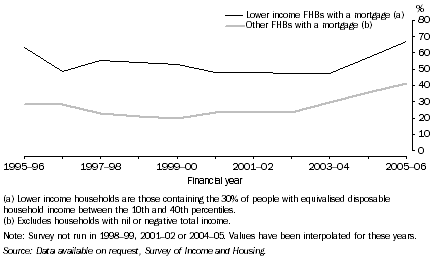
POTENTIAL FHB
Certain renters have similar economic circumstances to FHBs. People in these groups may become future FHBs or exhibit particular characteristics which suggest that their lifestyle preferences, investment decisions or other factors are leading to the choice, at least for the time being, for renting over owning a home. Other factors may involve job mobility or uncertainty about future employment.
Young high income renters
There are a number of people in young households (reference person aged under 35 years) who may potentially have the economic resources to purchase their own home, but who are currently renting. In 2005-06, 44% of people in young households in the top quintile of equivalised disposable household income (high income households) were renting.
Young high income renter households had mean net worth of $180,000. One in six (17%) of these households owned property (residential and/or non-residential) that they were not living in. For those who owned property, the mean value was $338,000, which is $14,000 lower than the mean value of property owned by young high income FHBs with a mortgage. Young high income renter households also had a mean value of $26,000 in shares in 2005-06 (see table 14 at the end of this article).
In 2005-06, young high income renter households were less likely than young high income FHBs with a mortgage to be in couple only households (38% compared to 57%) or to have dependent children (7% compared to 15%). Conversely, they were more likely to be in group households (22% compared to 5%). Despite the difference in family composition, the same proportion of each group had a bachelor degree or higher (56%).
FURTHER INFORMATION
Microdata records in the Confidentialised Unit Record Files (CURFs) released by ABS from the SIH are available for analysis and include fields for first home buyers and changeover buyers.
A full range of up-to-date information about the availability of ABS CURFs and about applying for access to CURFs is available via the ABS web site <https://www.abs.gov.au> (see Services We Provide, Confidentialised Unit Record Files (CURFs)). Inquiries to the ABS Microdata Access Strategies Section can be emailed to: microdata.access@abs.gov.au. Alternatively, telephone the section on (02) 6252 7714.
12. FHB with a mortgage, Selected household characteristics |
|
 |  |  |  | 1995-96 | 1996-97 | 1997-98 | 1999-00 | 2000-01 | 2002-03 | 2003-04 | 2005-06 |
Proportion of households with characteristic |
|
| Age group of reference person |  |  |  |  |  |  |  |  |  |
 | 15 to 24 | % | 9.6 | 12.6 | 9.2 | 9.5 | 10.5 | 12.2 | 10.0 | 14.7 |
 | 25 to 34 | % | 61.4 | 56.7 | 61.5 | 57.2 | 65.0 | 52.9 | 59.7 | 53.6 |
 | 35 to 44 | % | 23.4 | 22.4 | 22.0 | 24.8 | 19.0 | 25.6 | 23.2 | 21.7 |
 | 45 to 54 | % | *4.2 | 6.1 | 5.1 | 7.5 | *4.8 | 7.6 | 4.4 | 7.6 |
 | 55 to 64 | % | **0.9 | *2.2 | *2.1 | **1.0 | **0.7 | *1.7 | *2.3 | *1.6 |
 | 65 and over | % | **0.5 | - | - | - | - | **0.1 | **0.4 | **0.8 |
 | Total | % | 100.0 | 100.0 | 100.0 | 100.0 | 100.0 | 100.0 | 100.0 | 100.0 |
| Family composition of household |  |  |  |  |  |  |  |  |  |
 | One family households |  |  |  |  |  |  |  |  |  |
 |  | Couple family with dependent children | % | 36.6 | 36.2 | 34.7 | 35.1 | 30.5 | 33.6 | 31.4 | 34.6 |
 |  | One parent family with dependent children | % | *3.4 | *2.7 | 3.2 | *4.1 | *4.0 | 4.4 | 4.7 | *2.7 |
 |  | Couple only | % | 32.0 | 31.0 | 34.1 | 30.8 | 34.5 | 29.4 | 34.6 | 33.5 |
 |  | Other one family households | % | *3.9 | *4.4 | *5.1 | *4.7 | 6.1 | 5.7 | 4.0 | *5.3 |
 | Multiple family households | % | - | **1.8 | *2.4 | **1.8 | **0.2 | *1.0 | **0.3 | **0.6 |
 | Non-family households |  |  |  |  |  |  |  |  |  |
 |  | Lone person | % | 17.4 | 18.4 | 14.9 | 14.8 | 16.9 | 20.2 | 20.0 | 20.0 |
 |  | Group households | % | 6.8 | 5.5 | *5.6 | 8.7 | 7.8 | 5.7 | 5.1 | *3.3 |
 | Total | % | 100.0 | 100.0 | 100.0 | 100.0 | 100.0 | 100.0 | 100.0 | 100.0 |
| Number of employed persons |  |  |  |  |  |  |  |  |  |
 | None | % | 5.6 | 5.1 | *4.4 | *3.5 | *4.2 | 4.7 | *3.9 | *1.7 |
 | One | % | 36.0 | 39.6 | 36.5 | 37.4 | 38.2 | 41.0 | 37.8 | 40.9 |
 | Two | % | 54.6 | 50.1 | 54.7 | 51.4 | 52.6 | 50.4 | 54.2 | 54.1 |
 | Three or more | % | *3.8 | *5.2 | *4.4 | *7.7 | *5.0 | *3.9 | 4.1 | *3.4 |
 | Total | % | 100.0 | 100.0 | 100.0 | 100.0 | 100.0 | 100.0 | 100.0 | 100.0 |
| Level of highest non-school qualification - Household reference person |  |  |  |  |  |  |  |  |  |
 | Bachelor degree or higher | % | 18.0 | 19.0 | 17.4 | 19.9 | 23.7 | 22.4 | 30.2 | 33.1 |
 | Advanced diploma and diploma or below | % | 39.6 | 40.3 | 37.1 | 40.4 | 38.2 | 36.5 | 37.8 | 36.8 |
 | No non-school qualification | % | 42.4 | 40.8 | 45.5 | 39.4 | 37.5 | 38.9 | 30.8 | 29.0 |
 | Total(a) | % | 100.0 | 100.0 | 100.0 | 100.0 | 100.0 | 100.0 | 100.0 | 100.0 |
| Dwelling structure |  |  |  |  |  |  |  |  |  |
 | Separate house | % | 84.7 | 82.7 | 82.5 | 81.9 | 80.6 | 77.0 | 82.8 | 72.3 |
 | Semi detached/row or terrace house/townhouse | % | 7.9 | 10.0 | *6.4 | 10.7 | 8.3 | 11.1 | 9.8 | 15.2 |
 | Flat/unit/apartment | % | 7.4 | 7.3 | 10.8 | *7.1 | *10.6 | 11.6 | 7.4 | 11.5 |
 | Total(b) | % | 100.0 | 100.0 | 100.0 | 100.0 | 100.0 | 100.0 | 100.0 | 100.0 |
| New or established dwelling |  |  |  |  |  |  |  |  |  |
 | New dwelling | % | 22.7 | 23.1 | 17.4 | 15.5 | 19.5 | 21.3 | 17.6 | 13.5 |
 | Established dwelling | % | 77.3 | 76.9 | 82.6 | 84.5 | 80.5 | 78.7 | 82.4 | 86.5 |
 | Total | % | 100.0 | 100.0 | 100.0 | 100.0 | 100.0 | 100.0 | 100.0 | 100.0 |
| Number of bedrooms in dwelling |  |  |  |  |  |  |  |  |  |
 | One bedroom | % | *2.2 | *1.8 | **1.0 | *1.4 | *1.8 | *1.6 | *2.5 | *3.0 |
 | Two bedrooms | % | 22.7 | 21.2 | 22.9 | 21.9 | 21.0 | 21.8 | 21.4 | 22.5 |
 | Three bedrooms | % | 61.5 | 58.4 | 57.7 | 56.2 | 57.1 | 54.2 | 57.4 | 53.8 |
 | Four bedrooms | % | 13.0 | 17.0 | 16.4 | 19.0 | 18.1 | 20.6 | 16.5 | 19.1 |
 | Five or more bedrooms | % | **0.7 | *1.6 | *1.9 | **1.5 | *2.0 | *1.8 | *2.1 | *1.5 |
 | Total(c) | % | 100.0 | 100.0 | 100.0 | 100.0 | 100.0 | 100.0 | 100.0 | 100.0 |
| Equivalised disposable household income(d) |  |  |  |  |  |  |  |  |  |
 | Lowest quintile | % | 7.2 | 10.8 | 9.1 | 9.8 | 8.5 | 7.7 | 7.3 | 6.8 |
 | Second quintile | % | 13.3 | 9.5 | 9.0 | 9.8 | 9.5 | 15.1 | 9.6 | 10.8 |
 | Third quintile | % | 18.3 | 16.3 | 21.3 | 17.4 | 17.5 | 21.0 | 18.6 | 22.0 |
 | Fourth quintile | % | 24.4 | 21.3 | 25.6 | 25.4 | 27.2 | 23.3 | 28.2 | 27.8 |
 | Highest quintile | % | 36.7 | 42.1 | 34.9 | 37.6 | 37.3 | 32.9 | 36.2 | 32.6 |
 | Second and third deciles | % | 9.8 | 9.4 | 7.6 | 10.2 | 7.5 | 8.4 | 7.4 | 8.9 |
 | Total | % | 100.0 | 100.0 | 100.0 | 100.0 | 100.0 | 100.0 | 100.0 | 100.0 |
|
|
 |  |  |  |  |  |  |  |  |  |
 | Average age of reference person | years | 32 | 32 | 32 | 33 | 31 | 33 | 33 | 33 |
 | Average number of persons in household | no. | 2.60 | 2.66 | 2.62 | 2.70 | 2.51 | 2.58 | 2.48 | 2.50 |
 | Average number of bedrooms in dwelling | no. | 2.88 | 2.95 | 2.96 | 2.97 | 2.98 | 2.99 | 2.95 | 2.94 |
 |  |  |  |  |  |  |  |  |  |
 | Mean value of dwelling in 2005-06 dollars(e) | $'000 | 165 | 179 | 183 | 220 | 207 | 255 | 282 | 310 |
 | Mean gross household income in 2005-06 dollars(e) | $ per week | 1 164 | 1 292 | 1 268 | 1 439 | 1 400 | 1 339 | 1 458 | 1 544 |
 | Mean disposable household income in 2005-06 dollars(e) | $ per week | 928 | 1 006 | 1 005 | 1 101 | 1 098 | 1 052 | 1 146 | 1 215 |
 | Mean net worth in 2005-06 dollars(e) | $'000 | na | na | na | na | na | na | 232.5 | 235.9 |
 | Mean equity in dwelling in 2005-06 dollars(e) | $'000 | 60 | 65 | 70 | 81 | 73 | 97 | 108 | 97 |
 | Mean amount of mortgage outstanding in 2005-06 dollars(e) | $'000 | 105 | 114 | 113 | 139 | 134 | 158 | 174 | 213 |
 |  |  |  |  |  |  |  |  |  |
 | Mean housing costs in 2005-06 dollars(e) | $ per week | 299 | 293 | 279 | 294 | 303 | 304 | 367 | 415 |
 | Housing costs as a proportion of gross income(f) | % | 26 | 22 | 20 | 20 | 21 | 23 | 25 | 27 |
 | Mean disposable household income less housing costs in 2005-06 dollars(e) | $ per week | 629 | 712 | 727 | 807 | 795 | 748 | 779 | 800 |
 |  |  |  |  |  |  |  |  |  |
 | Estimated number of households | '000 | 318.2 | 329.9 | 387.1 | 328.2 | 358.2 | 384.2 | 372.8 | 303.3 |
 | Number of households in sample | no. | 331 | 362 | 373 | 299 | 318 | 507 | 547 | 363 |
|
| * estimate has a relative standard error of 25% to 50% and should be used with caution |
| ** estimate has a relative standard error greater than 50% and is considered too unreliable for general use |
| - nil or rounded to zero (including null cells) |
| na not available |
| (a) Includes level not determined. |
| (b) Includes other dwelling types. |
| (c) Includes bed-sits and dwellings with no bedrooms. |
| (d) See paragraphs 38 to 45 of the explanatory notes. |
| (e) Adjusted for changes in the Consumer Price Index. |
| (f) Excludes households with nil or negative total income. |
13. FHB with a mortgage, 2005-06 |
|  |
 |  |  |  | Lower income FHBs with a mortgage(a) | Other FHBs with a mortgage | All FHBs with a mortgage |  |
Proportion of households with characteristic |  |
|  |
| Age group of reference person |  |  |  |  |  |
 | 15 to 24 | % | *18.7 | 14.1 | 14.7 |  |
 | 25 to 34 | % | 31.6 | 57.2 | 53.6 |  |
 | 35 to 44 | % | 35.2 | 19.5 | 21.7 |  |
 | 45 to 54 | % | *12.0 | 6.8 | 7.6 |  |
 | 55 to 64 | % | - | *1.8 | *1.6 |  |
 | 65 and over | % | **2.5 | **0.6 | **0.8 |  |
 | Total | % | 100.0 | 100.0 | 100.0 |  |
| Family composition of household |  |  |  |  |  |
 | One family households |  |  |  |  |  |
 |  | Couple family with dependent children | % | 54.5 | 31.4 | 34.6 |  |
 |  | One parent family with dependent children | % | *5.8 | *2.2 | *2.7 |  |
 |  | Couple only | % | *15.3 | 36.4 | 33.5 |  |
 |  | Other one family households | % | **7.0 | *5.0 | *5.3 |  |
 | Multiple family households | % | **4.6 | - | **0.6 |  |
 | Non-family households |  |  |  |  |  |
 |  | Lone person | % | *12.8 | 21.1 | 20.0 |  |
 |  | Group households | % | - | *3.9 | *3.3 |  |
 | Total | % | 100.0 | 100.0 | 100.0 |  |
| Number of employed persons |  |  |  |  |  |
 | None | % | **2.5 | *1.6 | *1.7 |  |
 | One | % | 68.8 | 36.3 | 40.9 |  |
 | Two | % | *26.0 | 58.7 | 54.1 |  |
 | Three or more | % | **2.7 | *3.5 | *3.4 |  |
 | Total | % | 100.0 | 100.0 | 100.0 |  |
| Housing costs as a proportion of gross income(b) |  |  |  |  |  |
 | 25% or less | % | 30.9 | 41.2 | 39.8 |  |
 | More than 25% to 30% | % | **1.8 | 17.5 | 15.3 |  |
 | More than 30% to 50% | % | 41.6 | 33.4 | 34.5 |  |
 | More than 50% | % | *25.6 | 7.9 | 10.4 |  |
 | Total | % | 100.0 | 100.0 | 100.0 |  |
|  |
|  |
 |  |  |  |  |  |
 | Average age of reference person | years | 35 | 32 | 33 |  |
 | Average number of persons in household | no. | 3.35 | 2.36 | 2.50 |  |
 |  |  |  |  |  |
 | Mean value of dwelling | $'000 | 260 | 318 | 310 |  |
 | Mean gross household income | $ per week | 878 | 1 654 | 1 544 |  |
 | Mean disposable household income | $ per week | 762 | 1 290 | 1 215 |  |
 | Mean net worth | $'000 | 205 | 241 | 236 |  |
 | Mean equity in dwelling | $'000 | 86 | 99 | 97 |  |
 | Mean amount of mortgage outstanding | $'000 | 174 | 219 | 213 |  |
 |  |  |  |  |  |
 | Mean housing costs | $ per week | 299 | 434 | 415 |  |
 | Housing costs as a proportion of gross income(b) | % | 34 | 26 | 27 |  |
 | Mean disposable household income less housing costs | $ per week | 462 | 855 | 800 |  |
 |  |  |  |  |  |
 | Estimated number of households | '000 | 42.8 | 260.5 | 303.3 |  |
 | Number of households in sample | no. | 52 | 311 | 363 |  |
|  |
| * estimate has a relative standard error of 25% to 50% and should be used with caution |
| ** estimate has a relative standard error greater than 50% and is considered too unreliable for general use |
| - nil or rounded to zero (including null cells) |
| (a) Lower income households are those containing the 30% of people with equivalised disposable household income between the 10th and 40th percentiles. |
| (b) Excludes households with nil or negative total income. |
 Print Page
Print Page
 Print All
Print All